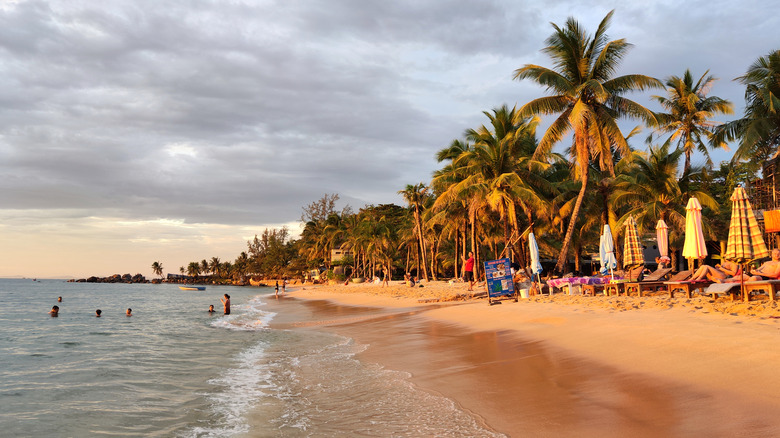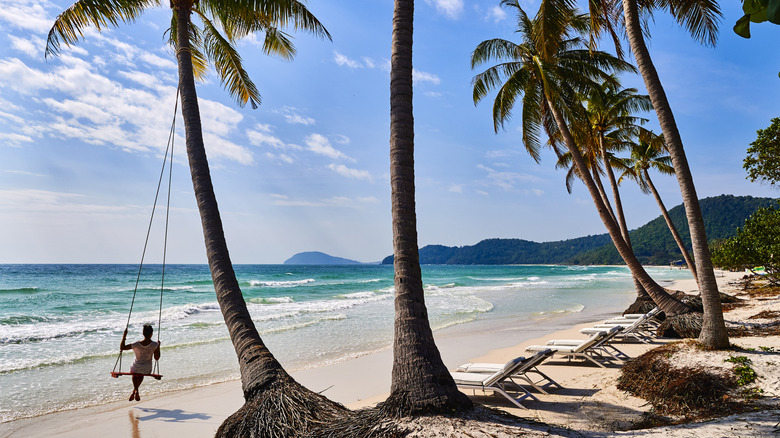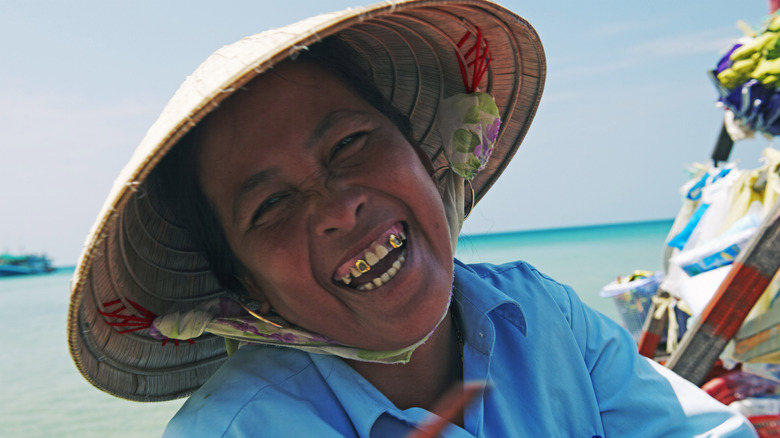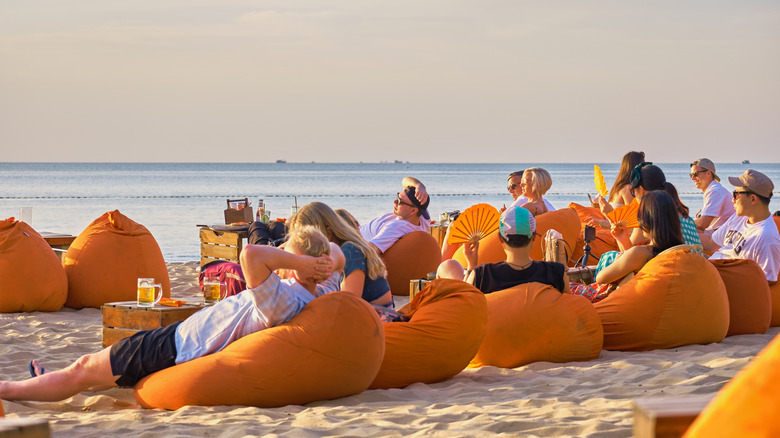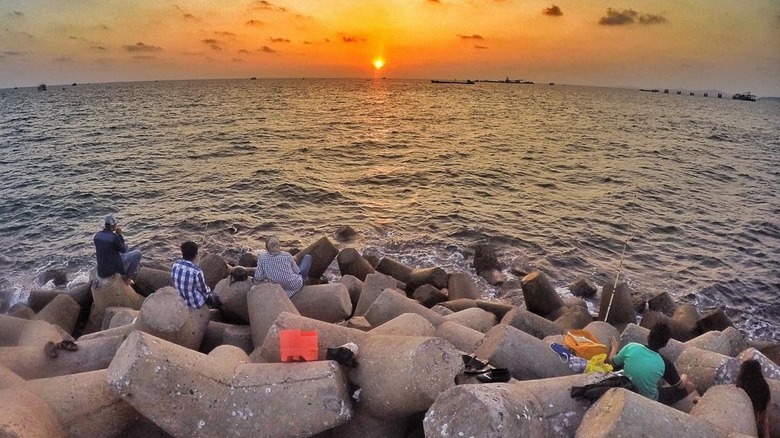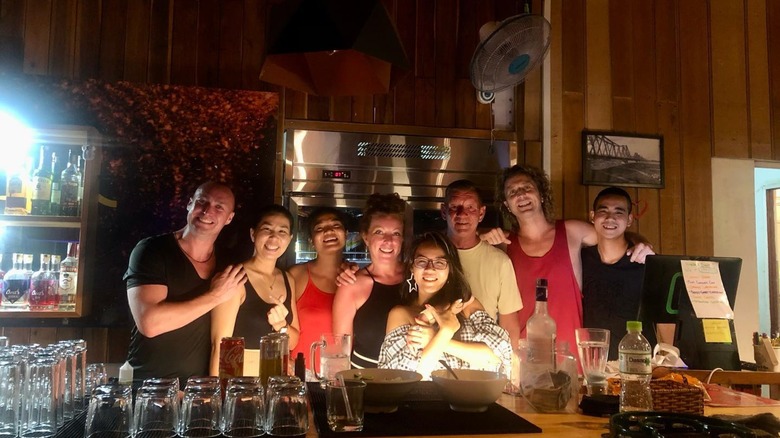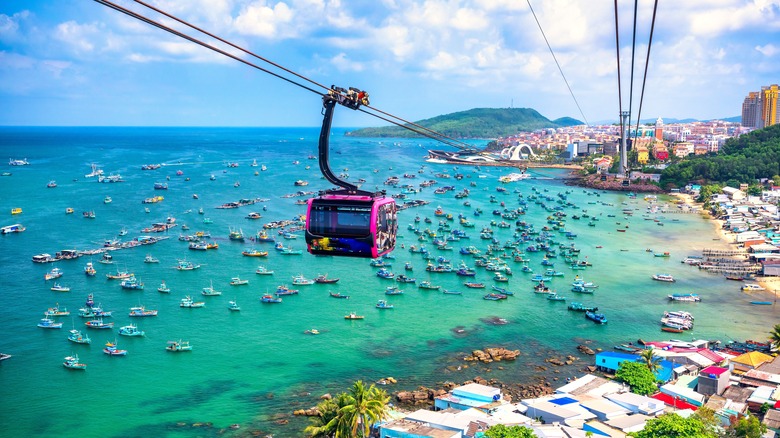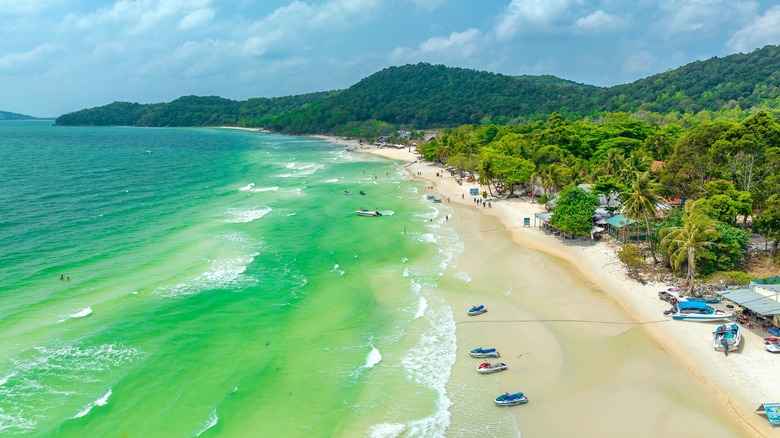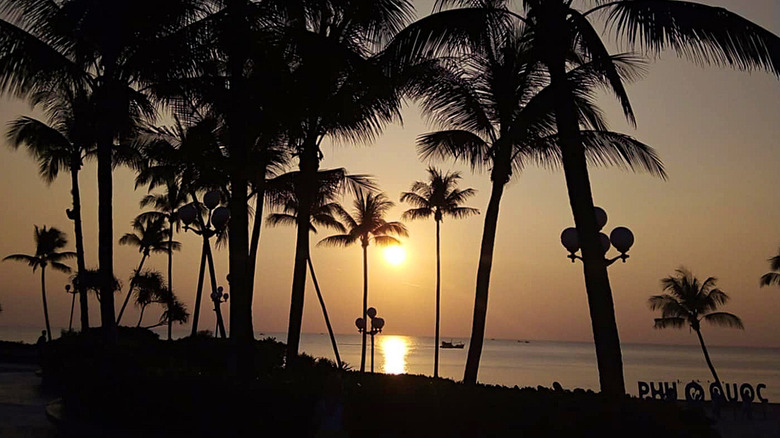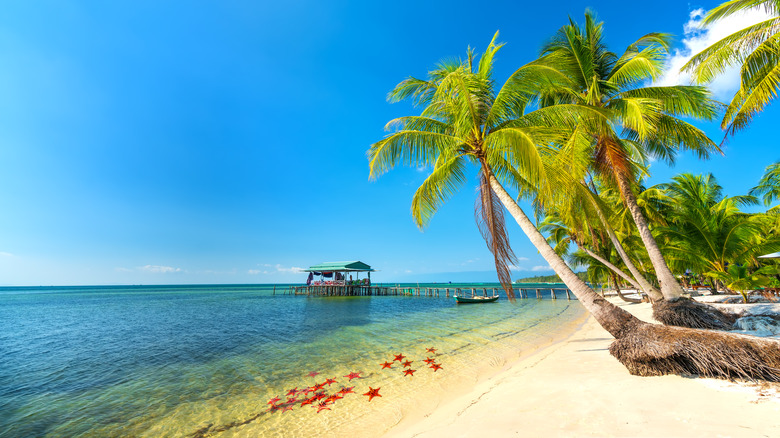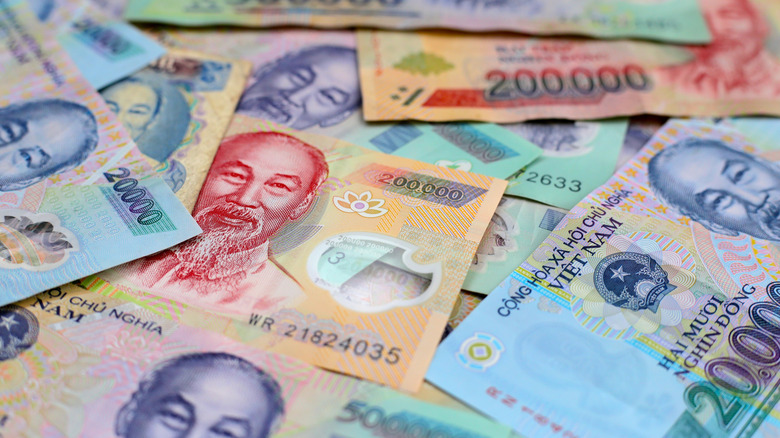Why I Keep Returning To Vietnam's Phú Quốc After Years Of Traveling Asia
Phú Quốc (pronounced Foo Kwock) is an island belonging to Vietnam in the Gulf of Thailand that's closer to Cambodia than it is to the Vietnamese mainland. It's huge, too, roughly the size of Singapore but with a fraction of the population and nowhere near the development. It's renowned for its white sand beaches and stunning sunsets, while it proudly exports the country's finest black pepper and fish sauce, as well as cultivated pearls, which contribute to Phú Quốc's "Pearl Island" nickname. As a result, it is one of the best islands to visit in Southeast Asia.
I had traveled and lived around Asia for 15 years before visiting Phú Quốc for the first time in 2020, just as the pandemic kicked in. When the Vietnamese government prepared to close its borders, it kindly gave travelers the option of returning to their homelands or staying. Many were on the next flight out, but I and a select few chose to remain, and it was one of the best decisions I ever made. For a couple of years, Phú Quốc became home for a few hundred travelers, who fell in love with the island and its people. And since that first flight out after the pandemic, I've kept coming back — here's why.
1. The pace of life is slow and peaceful
Time often stands still in Phú Quốc. People just go around at their own pace, and nobody is really in a hurry. While this might not be terribly convenient if you're hungry and the service is slow, when compared to the chaos of Vietnam's cities, you'll soon realize waiting a little isn't always a bad thing. Tourists generally spend their days getting massages on the beach, sipping cocktails, and eating fresh seafood. There are plenty of places dotted around the island where you can indulge, and relaxing isn't something you request; it's on the menu at all times.
Things can get a little busier around rush hour, especially in the Long Beach area. Travelers should be mindful on the roads at these times, whether riding a motorbike or just trying to walk across. The area around King Kong supermarket can get particularly busy, but the traffic intensity doesn't come close to what you may have experienced elsewhere in the country. Away from this small spot, just about everywhere else on the island remains serene and laid-back. People who decide to stay long term eventually get too used to the languid lifestyle, and returning to reality can be a problem. You have been warned.
2. The locals make you feel instantly at home
Vietnam may not be the first entry on tourist-friendly country lists, but in Phú Quốc, there doesn't seem to be any divide between foreigner and local. And this is despite the level of English on the island being somewhat lower than other places in the country. It may be culturally more conservative, too, but that isn't reflected in the openness to outsiders. When there's a big game on, you can sit with strangers by the roadside and watch it on their TV — and they'll share their snacks with you, too! When you're invited to a local home, the supply of food and drink never ends, and they don't expect anything in return. And, if you have a problem they can help with, they'll bend over backwards to assist you.
One story I like to tell to illustrate the kindness of Phú Quốc locals is the day I suffered some serious leg cramps while riding home after a day's strenuous hiking. I tried to stretch them out, but I could barely stand. A local man, seeing my obvious discomfort, came running out of his home with a bottle of what I can only describe as "magic oil." My cramps were miraculously cured by a complete stranger in the middle of the highway, and I was able to ride back home in comfort. He didn't have to help me, and he did not ask for repayment. Stories like this come up a lot when people talk about traveling through Asia, but to me, they seem even more common in Phú Quốc.
3. It's easy to meet other travelers
Many people are keen to meet other travelers when visiting a country because it's good to sit and swap stories with someone from a similar cultural background. In Phú Quốc, this isn't difficult. From the first day I arrived, I made numerous new friends. This trend continued throughout my time there; every time I go back, I meet dozens more, and I'm not exactly an extrovert. There's just something about this island that makes folks want to connect. The best place to meet other travelers is undoubtedly the Long Beach area, the area's social hub and top spot for restaurants and nightlife.
Some tourists like to spend the majority of their time within the confines of their resort. The convenience and quality on offer make it tempting to eat, drink, and enjoy the beach from there while only leaving to go on box-checking tours. Doing things this way prevents you from gaining real insights into the island, and it pays to get away from those creature comforts now and again, no matter how nice the pool is.
Other travelers are on a countrywide adventure, and Phú Quốc is just a small part of a big journey. Its southern location naturally means people often choose the island as their last stop, particularly if they arrived in the northern city of Hanoi. However, Phú Quốc airport is well connected, and you can choose to visit the island first before diving into the delights of the mainland. Doing so gives you easy access to firsthand advice from those who have already traveled Vietnam, and it means you avoid the chaos of "jumping in at the deep end" in either Hanoi or Ho Chi Minh City (Saigon).
4. The expat scene is open and relaxed
It's not just other travelers you'll meet on a visit to Phú Quốc. The expat scene is one of the most open I've ever experienced. In fact, when lounging in the island's cafes, bars, and restaurants, you'll often find travelers, locals, and expats all hanging out together, shooting the breeze. Friendships made are often for life and soon become another excuse for travelers like myself to keep returning. During the low season, tourist numbers are unsurprisingly pretty thin, and expat groups make do with entertaining themselves between thunderstorms. But, wherever you are on the island, these groups always swell during the peak season when tourists and returning travelers join in.
Whether you've been on the road for years or have just gotten off the plane, the expats in Phú Quốc are genuinely curious about you. The atmosphere is casual and welcoming, which is particularly refreshing if you've been wandering for a while. Digital nomads who find their lifestyle a bit lonely should beware; you may not want to leave this place. Everyday life may be low-key, but there aren't many destinations where the lines between tourist, expat, and local blur so easily. On Phú Quốc, it's just the way it is.
5. The nightlife is low-key but fun
During the pandemic, there were only a few bars open throughout the island. Today, there are many more, although the nightlife is still very low-key. Long Beach is where you'll find most of the action, but don't come expecting pumping parties. Instead, expect plenty of chat and lots of chill because nights usually revolve around exchanging stories and enjoying live music.
Establishments like the Irish-owned Rabbit Hole and the Cheeky Traveler English Pub have live bands or open mic nights with travelers singing their little hearts out. Children are welcome at the family-run Passion Pub, where you can also catch up on sports and enjoy a game of pool. Alternatively, with its excellent food and welcoming expats entertaining with amusing yarns, the Palm Tree is ideal for older travelers, while Hoppy Daze is a renowned spot for excellent craft beer and a welcoming atmosphere.
The only real problem is a lack of beach bars. They do exist, but tricky road access and limited parking can be a challenge. The beachside bar at Free Beach Resort has some incredible sunsets, as do the nearby Beach Shack and Phuong Binh House. Ocsen and Sunset Beach Bar cater more to domestic travelers, but there is, of course, nothing stopping foreign visitors from dropping by. Away from Long Beach, Rory's Beach Bar on the eastern side of the island is a large shipwreck-themed venue and a great place to spend the day next to the sea. Ironically, there's no real beach, but it does have saltwater pools, a mini golf course, and first-class food. If you're traveling in the low season, check to see if these places have closed temporarily before heading over to avoid disappointment.
6. It's not overdeveloped, but there's plenty to do
Phú Quốc received more than 6 million visitors in 2024, which is pretty staggering when you consider the population is less than 180,000. With all those travelers, you'd think it would be overdeveloped. Well, it is in certain areas. But, for the most part, it isn't. At least not yet. However, pockets have been aggressively developed for tourism to varying degrees of success.
In the northwest, you'll find Grand World, a somewhat tacky imitation of Venice complete with canals and gondolas. There's plenty to do in this area, especially for kids. VinWonders features a water park, an enormous aquarium, and the Wrath of Zeus roller coaster, as well as themed zones such as Viking Village and Fairy World. Then there's the Vinpearl Safari. As one who is usually careful when endorsing zoos, I can confirm this one is good. So good, in fact, there are troops of wild monkeys that the zoo claims moved in of their own accord and are now a permanent fixture.
In the far south of the island is Sunset Town, another purpose-built attraction with a Mediterranean theme. It's undeniably over-the-top, but it's also more tasteful than Grand World and even feels, dare I say it, more authentic. The iconic Kiss Bridge juts out into the sea, and every night there is a spectacular show with a big-budget mix of dancers, water jets, fire, lights, and 3D projections played out over the ocean that ends with a stunning fireworks finale. You'll also find one of the world's longest cable car rides. It elevates you over lush jungle, blue water, and hundreds of traditional fishing boats to take you the roughly 5 miles to Hòn Thơm Island, where you'll find more family-friendly attractions.
7. You're surrounded by nature
While development has encroached into the interior of the island, most of it is still lush jungle. The northeastern section, where you'll find the national park, is particularly verdant. It may not match the delights of Thailand's national parks, but there are still some excellent trails to explore.
For stunning views, a hike up Mount Chúa, the highest point on the island, is a tough option. The trail isn't signed, so it might be best to take a guide. Away from the national park, Tiên Sơn Đỉnh (Fairy Mountain) is a short but strenuous hike up a steep hill with outstanding views at the top. It's a little difficult to find, but you can access it from Cafe Tiên Sơn Đỉnh. The climb itself involves a couple of unavoidable ladders and even ropes in some difficult sections, so it's not a hike for everybody, but I have made it up plenty of times despite not being in the best shape of my life. At the top, there's a natural viewing platform where you can relax, and some kind soul has even strung up a couple of hammocks.
All that lush jungle is, of course, ringed by beautiful coastline. From the stunning beaches of the southeast to the popular areas of Long Beach and Ong Lang, there's sand for everyone. Further north, the beaches soon become more deserted once you pass the touristic delights of Grand World and everything that comes with that. With a little effort, you'll discover hidden coves and beaches, as well as Starfish Beach, which has become quite the tourist attraction. If you visit there, please do not pick up the starfish, as they do not survive very long out of the water.
8. The beaches are quiet, and the sunsets are stunning
Phú Quốc can get busy in the high season, but it never feels overcrowded. Even the most popular beaches offer sun and sea worshippers plenty of space. And while the shorelines don't have the jaw-dropping landscapes like those in southern Thailand or the Philippines, they are very nice, and at certain times of the year, stunning. I say certain times because the rainy season can bring trash, and local authorities still have some way to go to develop an efficient refuse collection system. You'll still see some garbage during the high season from November to April, but it's not as prevalent. You can generally expect the sand to be soft, the waters calm and clean, and the sun warm and nourishing without too many trash-based distractions.
Sao and Khem beaches, in the far southeast of the island, are the ones that can call themselves world-class. And that is reflected in the luxury resorts that have been built along the shoreline there. The water is turquoise blue, the sand is dazzling, and the restaurants by the sea have excellent views. It's a relaxing place to be, but it can feel somewhat isolated if you're keen to socialize.
The sunsets are on the other side of the island. For some of the best in the Gulf of Thailand, base yourself in the Long Beach area. It was almost a nightly event for me during the pandemic. The skies erupted with color just about every evening when the sun dipped below the horizon. The colors are dependent on the season, but they can range from crimson red highlighted by purples and blues to an eerie yet peaceful silvery shimmer.
9. The dry season is long
In Phú Quốc, the dry season typically runs from November to April, with good weather starting to kick in around October and sometimes running as late as May. During this time, skies are blue, humidity is low, and rain is nowhere to be seen. Tourists arrive from all over the world and have a great time before leaving for fresh destinations or returning home. Business owners on the island are much happier after what is often a challenging low season, and the general vibe of the place is positive, upbeat, and lively without being overwhelming.
The downside to a long dry season is a long wet season. We can't fault Mother Nature for her need to water the land, but when the downpours start kicking in around May and don't start their exit until October, it can be trying. That said, it's much quieter at this time, and costs are even lower. And it's not like it's pouring down 24 hours. The sun still exists, monsoon or not, and makes frequent appearances throughout the day.
It pays to carry an umbrella or waterproofs at this time, but it's hardly the end of the world. Things can get messy on the beaches with trash, while flooding and power cuts do occur. But it's the tropics, and Vietnam is a developing country, so it comes with the territory. Come in the high season if you need the best weather and a busier vibe. Otherwise, the rainy season is a good alternative as long as you're prepared, and flights and hotels will be cheaper, meaning you can splurge elsewhere.
10. It doesn't cost a fortune to stay in Phú Quốc
Vietnam makes the list of countries where the U.S. dollar goes the furthest. Due to this, Phu Quoc is one island vacation that won't bust your budget. With a little know-how, you could actually stay for under $20 a day, and that's with a few beers thrown in. Regular tourists generally spend more than that when you add up all the tours, trips, and dining splurges. However, with excellent visa options for most, you might just decide to hang around for a month, or even longer.
Budget accommodation on the island isn't as drab as it may sound. You can negotiate monthly stays in bungalows with a kitchen, AC, and a swimming pool on your doorstep for as little as $200. Gecko House and Seanna Apartments are two good options in the Long Beach area. However, there is luxury if you want it. Sheraton, Marriott, and Hilton all have a presence, while the best choices in the Long Beach area include Salinda and La Veranda. Then there's LAM Bungalows further inland, which offers luxury at surprisingly low prices.
Motorbike rentals are cheap, especially when hiring monthly, and food will barely make a dent in your wallet. You can find delicious and affordable meals all around, including at the artfully decorated Z Family Restaurant for both quality Vietnamese and excellent Western dishes. Nora's Cafe next door is a good spot for vegetarian food, while family-run street-side eateries have just about everything you could want, from ice cream to traditional Vietnamese baguettes (bánh mì). Additionally, you never have to go far for fresh and affordable seafood. Xin Chao is one of the most popular restaurants for fans of marine cuisine. In the main city, Dương Đông, you'll find street food everywhere with oysters, squid, and sea snails on the grill.
